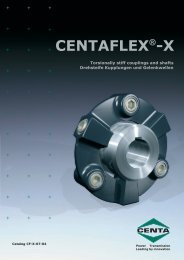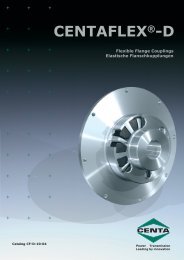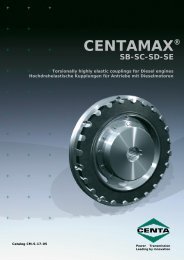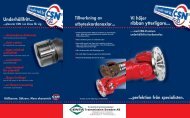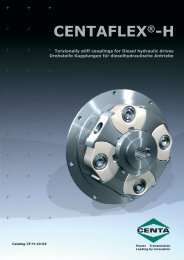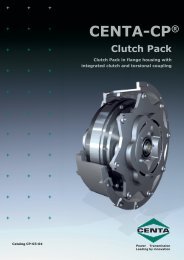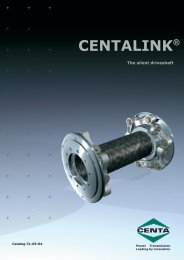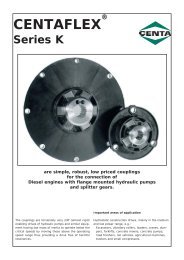CENTAX - CENTA Power Transmission - Sweden
CENTAX - CENTA Power Transmission - Sweden
CENTAX - CENTA Power Transmission - Sweden
Erfolgreiche ePaper selbst erstellen
Machen Sie aus Ihren PDF Publikationen ein blätterbares Flipbook mit unserer einzigartigen Google optimierten e-Paper Software.
5. Allowable continuous vibratory torque (acvt)The allowable continuous vibratory torque is theamplitude of the continuously allowable periodic torquefluctuation with a basic load up to the value T KNup to a frequency of 10 Hz, and a maximum ambienttemperature of 30°C.The value for the allowable continuous vibratory torqueis a value for the mechanical strength of therubber element. This value is of course limited and,where relevant, reduced by the ambient temperatureand the effective frequency of the vibratory torque.These influences are nowadays taken into considerationin the calculation of the allowable power loss(section 8) and do not have to be taken into accountin this case.6. Dynamic torsional stiffnessThe dynamic torsional stiffness is the relationship ofthe torque to the torsional angle under dynamicloads.The torsional stiffness is constant in <strong><strong>CENTA</strong>X</strong> couplings,i.e. the characteristics is straight or linear, itdoes not change with the torque.Due to the physical properties of the material rubber,the dynamic torsional stiffness of a coupling iswidely depending on the following influences:a) TemperatureHigher temperature reduces the dynamic torsionalstiffnessb) Frequency of vibrationHigher frequencies increase the dynamic torsionalstiffness. That means, that the dynamic torsionalstiffness is higher than the static stiffness.Typically: C Tdynª 1,3 C stat.c) Amplitude of vibratory torqueHigher amplitudes reduce the dynamic torsionalstiffness, therefore small amplitudes result in higherdynamic stiffness.For <strong><strong>CENTA</strong>X</strong> couplings, the torsional stiffness ismeasured on our own test rigs and specified withthe following marginal conditions:preload:0,5 · T KNvibratory torque: ± 0,25 · T KNfrequency:10 Hzambient temperature: t u= 20°CTolerances in the rubber quality can mean that thedynamic torsional stiffness will deviate by ± 15%from the catalog value.In an ambient temperature of more than 30°C, thetorsional stiffness will decrease.5. Zulässiges DauerwechseldrehmomentDas zulässige Dauerwechseldrehmoment ist die Amplitudeder dauernd zulässigen, periodischen Drehmomentschwankungenbei einer Grundlast bis zumWert T KN, bis zu einer Frequenz von 10 Hz, und biszu einer Umgebungstemperatur von 30°C.Der Wert für das zulässige Dauerwechseldrehmomentist ein Wert für die mechanische Belastbarkeitdes Gummielementes. Dieser Wert wird natürlichdurch die Umgebungstemperatur und die effektiveFrequenz des Wechseldrehmomentes begrenzt undgegebenenfalls reduziert.Diese Einflüsse werden heutzutage bei der Berechnungder zulässigen Verlustleistung (Abschnitt 8)berücksichtigt.6. Dynamische DrehsteifigkeitDie dynamische Drehsteifigkeit ist das Verhältnisvon Drehmoment zu Drehwinkel bei dynamischerBelastung.Bei den <strong><strong>CENTA</strong>X</strong>-Kupplungen ist die Drehsteifigkeitkonstant, d.h. die Kennlinie ist gerade bzw. linear,sie verändert sich nicht mit dem Drehmoment.Durch die physikalischen Eigenschaften des WerkstoffesGummi, ist die dynamische Drehsteifigkeiteiner Kupplung u.a. von folgenden Einflüssen abhängig:a) TemperaturHöhere Temperatur reduziert die Drehsteifigkeitb) Frequenz der SchwingungenHöhere Frequenz steigert die Drehsteifigkeit. Dasbedeutet, daß die dynamische Drehsteifigkeithöher ist als die statische Drehsteifigkeit. Erfahrungswert:C Tdynª 1,3 C stat.c) Amplitude des WechselmomentesHöhere Amplituden reduzieren die Drehsteifigkeit,geringe Amplituten ergeben daher einehöhere Drehsteifigkeit.Für die <strong><strong>CENTA</strong>X</strong>-Kupplungen wird die Drehsteifigkeitauf unseren eigenen Prüfständen gemessen und mitfolgenden Randbedingungen festgelegt:Vorlast:0,5 · T KNWechseldrehmoment: ± 0,25 · T KNFrequenz:10 HzUmgebungstemperatur: t u= 20°CDurch Toleranzen in der Gummiqualität kann die dynamischeDrehsteifigkeit ± 15% von dem Katalogwertabweichen.Bei Umgebungstemperaturen über 30°C nimmt dieDrehsteifigkeit ab.The following then applies:C Tdyn red= C Tdyn · S t3Es gilt:C Tdyn red= C Tdyn · S t3CX-SEC-49Catalog CX-SEC-01-04



